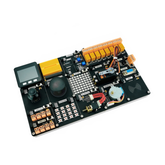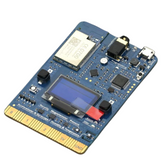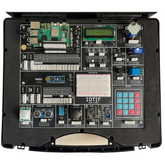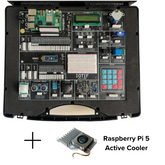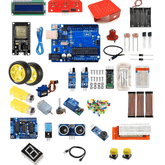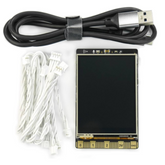How to do SSH into an IoT device?
Summary
Unlocking the potential of IoT devices demands secure access, and SSH emerges as a key solution. In our latest blog, 'How to do SSH into an IoT Device,' we delve into the essentials. Discover what SSH is and its inner workings, along with the invaluable security benefits it offers for IoT ecosystems. Learn the 4 essential steps to access IoT devices via SSH, and explore the challenges alongside their ingenious solutions. Plus, don't miss our expert-curated list of 10 best practices for SSH-driven IoT remote access. Uncover the key components of SSH in IoT and explore its diverse applications. Ready to elevate your IoT security? Read on!
Introduction
Have you thought about how to keep hackers out of our smart devices? That's where Secure Shell, or SSH, becomes useful. It's comparable to a superhero in our globalized society!
This blog will teach you everything there is to know about SSH and how it protects our Internet of Things devices. We'll go over the fundamentals and look at some real-world applications.
Are you prepared to learn about SSH and maintain the security of your devices now? Let's get started and learn more!
What is SSH?
The Secure Shell (SSH) protocol is like a secret passage for sending commands to a computer, even if it's connected to an unsafe network.
It ensures that only authorized devices may communicate with one another by using unique codes, and it protects all of the messages from strangers. SSH allows you to safely move files between computers and control them remotely.
Comparing it to earlier techniques like Telnet, which essentially broadcast commands for everyone to hear, it's far safer. SSH maintains confidentiality, much like a secret shell.

Let's say you want to access your home computer from a friend's house. You use SSH to connect securely. You type in your home computer's address and your username, and SSH asks for your password.
Once logged in, you can control your home computer as if you were there. SSH encrypts all communication, keeping it safe from prying eyes. It's like having a secret tunnel between computers.
How does SSH work?

- TCP/IP Protocol Suite: SSH operates over this crucial internet communication foundation, known as the TCP/IP protocol suite.
Delivery of data packets is handled by TCP, while IP uses addresses and ports to guide packets to their proper locations.
- Authentication: Devices and users are verified by SSH authentication. Devices use their public/private key pairs to authenticate one another.
A username and password are typically required for user authentication.
- Public Key Encryption: SSH uses a unique method known as public key encryption for protecting data. It requires two keys to function a public key that can be shared with anybody, and a private key that needs to be kept a secret.
A public key and a private key are unique to each SSH-enabled device and are used to securely encrypt and decode data.
- Symmetric Key Negotiation: SSH creates shared symmetric keys for additional encryption following device authentication.
The devices negotiate these keys, which are then used to encrypt the information sent back and forth throughout the SSH session.
- Secure Command Execution: Users can safely run commands on the remote computer after completing the authentication process.
SSH makes sure that all commands and data transmitted back and forth between devices are encrypted, protecting them from being read or altered.
- Identifying Characteristics: While HTTPS and other protocols primarily confirm the identity of the server, SSH authenticates the connection on both ends.
SSH also gives users access to the remote machine's command-line interface, which expands their control and management options.
The Benefits of Using SSH for IoT Security

- Security Against Unauthorized Access: SSH employs encrypted keys for authentication, guaranteeing that only authorized users can access and control Internet of Things devices.
This lowers the possibility of unwanted access, which raises serious security concerns for IoT devices.
- Data Integrity and Confidentiality: SSH's encryption guarantees the security and confidentiality of any data transferred between the client and the Internet of Things device.
This is essential for protecting private data, particularly in settings involving industrial sensors or data from healthcare monitoring systems.
- Secure Remote Management: By using SSH, administrators can safely and remotely carry out repairs, updates, and troubleshooting on Internet of Things devices, eliminating away with the necessity for on-site access.
This feature is especially helpful in difficult situations when Internet of Things devices are frequently placed in isolated or difficult-to-reach areas.
- Accountability and Audit Trails: SSH records all user contact with the IoT device, creating thorough audit trails. By enabling managers to monitor who accessed the device, when they did so, and what they did, these logs aid in upholding accountability.
Audit trails support forensic analysis in the event of security incidents.
- Mitigation of Middle Man Assaults: SSH is designed to survive assaults in which communication between the client and the server is intercepted by an unauthorized party.
SSH helps parties to confirm each other's identity using secure keys and certificates, reducing the possibility of harmful interference and enhancing security in general.
4 Steps to Access IoT Devices with SSH

SSH protocol is commonly used for remote access to IoT devices due to its strong encryption features. It ensures secure connections by employing various security measures such as user-generated credentials, multi-factor authentication (MFA), public key infrastructures (PKI), and zero-trust keyless solutions. These layers of security help authenticate legitimate users and deter malicious actors.
SSH makes it easy to access and handle Internet of Things devices, but exact setup and maintenance are necessary to guarantee security. The steps to use SSH to access and control IoT devices are as follows:
Step 1: Activate SSH on the IoT Device
Most recent UNIX, Mac, and Windows systems come with SSH protocol installed by default. In this step, turn on SSH on the IoT device first. Usually, this means gaining access to the device's administration interface and turning on the SSH service.
Step 2: Configure SSH Access Controls
After enabling SSH, set up access controls to restrict remote access to devices and users that are authorized. Setting up firewall rules, IP whitelisting, or user-based access controls may be necessary to guarantee that only authorized users are able to remotely access the device.
Step 3: Create SSH Key Pairs
On the IoT device and for the permitted users, create SSH key pairs if public-key authentication is being used. Then, to enable password less authentication and improve security, the public keys are added to the list of approved keys on the IoT device.
Step 4: Establish Connection with the IoT Device
Once SSH is configured, authorized users can connect to the IoT device using SSH client software like PuTTY or OpenSSH. They can then securely manage the device remotely through command-line interfaces.
Challenges and Solutions in Accessing IoT Devices with SSH
Accessing IoT devices remotely faces challenges like firewalls and protected IP addresses, which may restrict access and lead to risky practices. It is essential to use the Secure Shell (SSH) protocol in order to get beyond these obstacles.
Secure remote access is ensured by the encryption and authentication features provided by SSH. However, setting up appropriate authentication techniques and other technical skills are necessary for configuring remote access safely.
To reduce risks, regular upgrades and compliance to security best practices are crucial. For comprehensive instructions, users can consult guides such as the OpenSSH client configuration guide.
To efficiently manage remote access to IoT devices while protecting data and device integrity, security methods must be prioritized.
10 Best Practices for SSH-Driven IoT Remote Access

- Many IoT devices come with default login credentials, such as "pi" and "raspberry" for Raspberry Pi. Changing these default passwords immediately after setup is crucial to prevent unauthorized access.
- Using strong and unique usernames and passwords for all user accounts on IoT devices is essential for preventing unauthorized access. Weak or easily guessable credentials can be exploited by attackers through brute-force attacks or credential stuffing.
- Keeping IoT devices and SSH software up to date is crucial for maintaining security. Manufacturers release updates and patches to address known vulnerabilities and improve system security. Failure to install these updates promptly can leave IoT devices vulnerable.
- SSH key-based authentication offers a more secure alternative to password-based authentication. With SSH keys, users generate a pair of cryptographic keys a public key and a private key.
- Using strong passphrases for protecting the private key is important when using SSH key-based authentication. A passphrase adds an additional layer of security and functions similarly to a password for the private key.
- Disabling password-based authentication for SSH access is recommended to mitigate the risk of brute-force attacks. Attackers often attempt to guess passwords to gain unauthorized access to IoT devices. By disabling password authentication and relying solely on SSH keys, users can significantly reduce risk.
- Changing the default SSH port from 22 to a non-standard port can help deter automated attacks targeting the default port. it can make it more difficult for attackers to identify and target IoT devices.
- Restricting SSH access to specific IP addresses or ranges can further enhance security by preventing unauthorized access from unknown or untrusted sources. This can be achieved by configuring firewall rules or using tools like "fail2ban" to automatically block IP addresses with repeated failed login attempts.
- SSH access for the root user reduce the danger of unwanted access. Users should create distinct user accounts with restricted access instead of using the root account for SSH access. They should only use the "sudo" command to switch back to the root account when necessary.
- Enabling SSH session logging and regularly reviewing access logs are essential for detecting and responding to security incidents. SSH logs record details about SSH connections, including the IP addresses of clients, usernames, and timestamps.
Key Components of SSH in IoT
- Authentication: SSH depends on encryption key pairs for authentication in IoT environments. This requires a matching public key that is kept on the server and a private key that is kept on the Internet of Things device. Secure authentication is ensured by limiting access to the device to people who possess the relevant private key.
- Port Forwarding: SSH port forwarding enables safe access to services operating on the local network of the Internet of Things device. While preserving communication security, it enables users to engage remotely with particular apps or services. The ability to remotely manage and control Internet of Things devices is made possible by this functionality.
- Session Management: Strong session management features offered by SSH enable users to create and maintain safe connections with Internet of Things devices. It is possible to start, stop, and manage sessions securely, guaranteeing that the client and IoT device's communication is secure at all times.
- Encryption: SSH depends heavily on encryption to provide a safe channel for data transfer between the client and the Internet of Things (IoT) device. To ensure the secrecy and integrity of data transferred over the network, several encryption techniques are used. This is especially important in Internet of Things scenarios involving sensitive data, where strict security protocols are required to protect privacy and prevent illegal access.
- User Authorization: SSH uses user authorization techniques to control who can access Internet of Things devices. User accounts serve as the basis for access permission definitions, guaranteeing that only people with permission can carry out particular tasks on the device. This fine-grained control aids in preventing unwanted alterations or access to vital IoT equipment.
Applications of SSH in IoT
SSH's applications in the Internet of Things include: Protecting sensors and programmable logic controllers (PLCs) in industrial settings, Allowing homeowners to safely operate smart home appliances like security cameras and thermostats even when they are not at home.
Securing smart meters and traffic control systems to ensure the dependability of smart city operations, Protecting patient privacy in the healthcare IoT by enabling secure remote management of medical devices.
Conclusion
It's clear that Secure Shell (SSH) is essential to enhancing the security of our Internet of Things devices. SSH effectively prevents attackers by ensuring that only authorized users can connect with IoT devices through identity authentication, encryption, and secure remote access.
With this knowledge, we can better safeguard our smart devices and maintain the integrity of our global network. Let's keep utilizing SSH's capabilities and keep an eye out for online dangers.
Continue SSH-ing into IoT devices with confidence and be safe and secure! By working together, we can protect the future of our global community.



